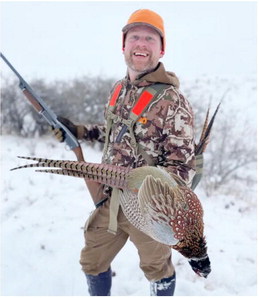Pathways To Clarity


Whether ‘corner-crossing’ will or won’t be legal in Montana is an ongoing and complex question. While solutions exist, landing on one that appeases all sides of the contentious debate won’t be easy.
(Editor’s Note: When four hunters used a specially constructed ladder to step from one corner of public land in southern Wyoming to another, the ripples from that decision were initially small but have since ignited an impassioned debate that could open — or unequivocally restrict — access to more than eight million acres of public land across the West. Here, in the final installment of our three-part series, we explore how judges, lawmakers and public land managers could clear up some of the legal ambiguity surrounding corner- crossing..)
The confluence of forces that created the checkerboard land ownership patterns that so vex many Montanans was not an overnight phenomenon. A slew of congressional acts, land transfers, lawsuits and governmental policies over the past 150 years all contributed to the uncertain, conflict-prone and impassioned debate surrounding corner-crossing — the act of passing from one parcel of public land to its kitty-corner neighbor.
Legal and political observers say they don’t expect quick fixes, but there’s no shortage of ideas that could establish a path forward so that recreationists, landowners, land managers and law enforcement officials can work out what constitutes fair play in a debate that implicates public access to more than eight million acres of “corner-locked” public land in the West.
Here are some potential solutions, along with their pros and cons, across the three branches of government: The Legislative Branch’s Role: Bills And Ballot Measures One of the most obvious solutions — making legislative changes to Montana’s trespassing laws — is relatively straightforward but not easy. Given sufficient political will, federal or state lawmakers could introduce bills that would make corner- crossing either explicitly legal or illegal.
State lawmakers introduced bills related to corner- crossing in 2005, 2013 and 2017, but none of those advanced particularly far, a reflection of a dynamic that some observers have described as a “lose-lose” prospect for many politicians in the state’s Republican-controlled Legislature.
Still, creating a law specific to Montana has proponents, including Sawyer Connelly, a law student at the University of Montana who drafted legislation aimed at addressing some of the landowner-related concerns, namely anxiety over civil liability, that have prevented legislatures in Western states from legalizing corner-crossing in the past.
Connelly said his model legislation was inspired by the Montana Stream Access Law, which allows anglers to wade Montana’s streams, provided they stay below the high-water mark. Montanans may now view that law as a kind of bedrock recreational law, but Connelly noted that it was the result of “test case” litigation that involved constitutional claims and an extensive — and expensive — legal battle. Stream access and corner-crossing both involve public access and private property rights, which Connelly described as “colossal issues” in the West. Still, landowners are interested in making headway, he said. “It’s just a delicate issue.”
The dynamic could work the other way, too: Groups that oppose corner-crossing, like the United Property Owners of Montana or the Montana Stockgrowers Association, could push legislation to make the practice illegal, a position based on their argument that corner- crossing represents a “taking” of a private property right. Bozeman-based Hunt Talk Radio host Randy Newburg told Montana Free Press that he expects lawmakers in western states, including Montana, to at least consider introducing such legislation in the wake of a Wyoming judge’s May 2023 order that sided with four corner-crossing hunters. He wouldn’t be surprised, he added, if lawmakers introduce a statutory minimum penalty for civil trespassing as one way to deter corner-crossing.
Lewistown-based public land advocate E. Donnall Thomas Jr. argued in a 2021 Outside Bozeman story that legal clarity could come from other avenues. Thomas argued that an impasse at the Capitol need not sink all attempts to change state law. A citizens’ ballot initiative, Thomas wrote, might be a more practical approach toward legalizing corner-crossing. That involves gathering a set amount of signatures — currently about 60,000 — from a geographically diverse chunk of Montana in order to put the question directly to voters.
Thomas noted that ballot initiatives can be a gamble — and a time-intensive, costly one at that. They can also be “manipulated” before they become law, according to John Sullivan, the chair of the Montana chapter of Backcountry Hunters and Anglers. Montana’s last successful citizen ballot initiative, which legalized adult-use marijuana and established that a percentage of the tax collected from it would go toward conservation initiatives, among other things, is an instructive case on political meddling with ballot initiatives, Sullivan said. (A 2023 bill building off that ballot initiative won support from a majority of lawmakers before becoming mired in a procedural, and ongoing, limbo in the final hours of the session.)
It’s also possible that the U.S. Congress could pass federal legislation to clear up the issue. Joel Webster, vice president of Western conservation with the Theodore Roosevelt Conservation Partnership, said it would take strong bipartisan cooperation to achieve meaningful progress there — something he doesn’t find an abundance of in our current political climate.
“I really do not see U.S. Congress moving anything on this,” Webster said. “It’s too hard.”
Executive Branch Solutions: Easements, Purchases, Swaps And Landowner Reimbursements Though generally more piecemeal, solutions to the checkerboard access conundrum could come from federal or state agencies, which could — and do — pursue policies and programs to facilitate public use of corner-locked public land. One solution that could have the most widespread impact is also likely to garner the stiffest opposition from landowners and private property advocates. Agencies like the Bureau of Land Management could use eminent domain, which allows government agencies to seize private land for public use (provided they give the landowner “just compensation”). Even stalwart access advocates are wary of this. Sullivan, with BHA, told MTFP that he deems it “too much of a takings” to garner his personal support. A proposal more likely to find a receptive audience with landowners involves the voluntary negotiation of easements, which would allow property owners to play an active role in shaping how and where the public crosses their land to get to public land. Landowners could, for example, specify that an easement permits access to a particular contingent of the public, e.g., non-motorized users only, across corners for a particular stretch of months.
Kent Hanawalt, who runs a cattle ranch east of Livingston that his wife’s family homesteaded in the late 1800s, told MTFP that he generally finds the issue of corner-crossing “absolutely grey, through and through” but is “also absolutely open to hear all the sides and make the difficult decision toward the middle.” Negotiated easements, he said, present one such middle solution — though not without its own share of potential downsides.
Hanawalt said he supports public access to public land but is wary of some of the consequences that could accompany hunters’ use of the public section neighboring his. Those include stray bullets, erosion (particularly if ATVs are used), invasive weeds and the potential for wildfire or hunter-wounded wildlife that are left in the field, he said.
Hanawalt said assurances from the neighboring public land manager that they’ll take responsibility for cows killed by errant bullets, weed introduction or soil erosion would go a long way toward alleviating those fears.
There’s also a scalability consideration at play with this approach. A recent report by the mapping app OnX counted more than 27,000 corners throughout the West where two parcels of public land meet on opposite sides of a point, with private land adjacent, so making a dent in the problem with this tool alone would require a whole lot of negotiations with a whole lot of landowners.
Hanawalt also supports another federal policy proposal, discussed during the University of Montana’s 2023 Public Land Law Conference, that would make public access to public land that’s grazed by a private entity a condition of their U.S. Forest Serviceor Bureau of Land Management- administered grazing lease.
The federal government could also secure a public right-of-way with strategic purchases to access corner- locked land. Webster, with TRCP, said the Land and Water Conservation Fund could be used to make smaller strategic purchases of key parcels as well as larger purchases of entire sections that could help dissolve some of the checkerboarding at the root of the issue. It helps, he said, that the LWCF is now permanently funded and approximately $60 million of it is set aside specifically for access initiatives. Of course, the public buying those strategic parcels would require willing sellers.
Land swaps are another solution that’s discussed in access, conservation and property rights circles. Unlike an outright purchase, a land swap involves the release of some federal land in exchange for the acquisition of some private land. Land swaps are time-intensive, costly and sometimes controversial, but they’ve also been effective in resolving the checkerboard land ownership pattern and can garner landowner support. Indeed, they’ve been used extensively in the Custer Gallatin National Forest to consolidate public land in the Bridger and Bangtail mountains.
Most recently, Forest Service leadership has authorized a swap in the South Crazies and is weighing another swap along the Crazies’ eastern edge. One of the agency’s primary motivations in initiating the latter swap was to consolidate checkerboard ownership patterns, which “contributed to over a century of complicated management situations and problematic access issues for all users,” according to a September 2023 press release about the agency’s decision to tentatively authorize the swap.
At the state level, there are incentive-based, voluntary programs that reward landowners for opening access to public hunters through payments and tax incentives. Some programs, like the Unlocking Public Lands and Public Access Land Agreement, are specifically tailored for just these scenarios. In 2023, PALA agreements collectively opened access to 540,000 acres of inaccessible or “under-accessible” acres of public land, according to Ed Beall, who chairs the Private Land/Public Wildlife Advisory Council. (The Unlocking Public Lands program, which is tax-incentive based, rather than payment-based, has more modest participation, opening access to about 2,500 acres last year.)
Beall said these programs distinguish Montana from Wyoming, where there isn’t such robust access to checkerboard public land. Programs like PALA also help to create a cooperative environment between recreationists and the private landowners who help support the healthy wildlife populations that many Montanans celebrate, he said. Though generally lauded by hunters, the agencies that administer them and the lawmakers who authorized them, such programs create a somewhat short-term fix: The maximum length of an access agreement is 10 years.
Judicial Branch Rulings
Nearly everyone interviewed for this series agreed that the next big development in the corner-crossing debate will likely come from the judiciary.
Much will depend on the 10th U.S. Circuit Court of Appeals, which is evaluating a lower court’s finding that four Missouri hunters did not civilly trespass when they used a ladder to corner-cross multiple sections of BLM land interspersed with a private ranch during a 2021 hunting trip. Groups from both sides of the corner-crossing issue — including a few active in Montana — have submitted a rash of filings to the 10th Circuit, hoping to steer the court’s eventual ruling.
The three-judge panel assigned to that appeal could issue a ruling by the year’s end that will apply to states in the 10th Circuit: Wyoming, Utah, Colorado, New Mexico, Kansas and Oklahoma. The ruling could also lend some “persuasive authority” to other appellate courts, including ours, the Ninth Circuit. The lawsuit could even find its way all the way up to the U.S. Supreme Court.
When the 10th Circuit ruling comes down, the other two branches of government are expected to take notice. Newburg hypothesizes that the “let-the-sleeping-doglie” strategy federal agencies have generally employed to avoid aggravating stakeholders on either side of the debate will no longer be tenable. Instead, Newburg believes, those agencies will be forced to reevaluate their roles in the access debate.
Similarly, a ruling could spur western state legislatures to overcome the inertia that’s plagued the is-cornercrossing- a-trespass That, in turn, could inspire yet more lawsuits and rulings in this still-evolving legal arena, Sullivan said.
“No matter what happens on either side, I think it’s going to end up in a courtroom,” Sullivan said. “That’s me looking through the crystal ball.”
~~~~~~~~~~~~~~~~~~~~~~~~~~~~~~~~~~~~~~~~~~~~~~~~ “I really do not see U.S. Congress moving anything on this. It’s too hard.”
JOEL WEBSTER, THEODORE ROOSEVELT CONSERVATION PARTNERSHIP
~~~~~~~~~~~~~~~~~~~~~~~~~~~~~~~~~~~~~~~~~~~~~~~~




